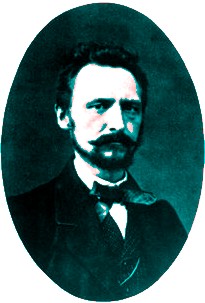Adolph Fick (1829-1901)
Adolph Fick made his entry into this world in 1829 in Cassel, Germany. Early in life, Adolph showed a remarkable talent for mathematics and physics. He enrolled at the University of Marburg with the express purpose of acquiring the appropriate academic credentials in these two related disciplines.

However, under the prodding of his brother Heinrich, who was professor of law, young Adolph was persuaded to matriculate in medicine, a field that Heinrich felt would certainly benefit from Adolph's expertise in mathematics and physics.
Soon after taking his medical degree, Fick turned his attention to physiology, accepting a prosectorship with Carl Ludwig in Zurich. The year was 1852 and Fick was a mere 23 years of age. He was to remain with Ludwig for 16 years, leaving Zurich to accept the chair of physiology in Würzburg. Throughout his stay at Zurich, Fick made many contributions as a scientist well versed in mathematics, physics, and physiology, as brother Heinrich had already perceived.He was a quiet, scholarly man whose pastimes included pursuit of his marked interest in philosophy and literature. Fick's first contribution as a physicist was made in 1855 when he was just 26 years old.
It consisted of a concept that he developed mathematically from Fourier's theory of heat equilibrium. The resulting statement put forth the physically sound and logical view that diffusion is proportional to concentration gradient. Experimental proof of the view was provided 25 years later.
A year after this distinctive achievement, Fick published a well-rounded monograph entitled Medical Physics. Here, for the first time, he introduced his thoughts on certain physiologic problems such as the mixing of air in the lungs, measurement of carbon dioxide output in humans, the heat economy of the body, and the work of the heart. The monograph was a gold mine of information. Aside from a detailed discussion of the mechanics of muscular contraction and the molecular physics of gases and water, optics, color vision, animal heat, and conservation of energy, it dealt with hydrodynamics of the circulation fortified with sound recordings of circulatory events. It was the first book of its kind, and medicine had to wait almost a century before it yielded its landmark status to Otto Glasser's monumental Medical Physics.
Throughout his tenure of more than three decades at Würzburg, and in his quiet unassuming manner, Fick contributed a steady and focused stream of information that was always on the cutting edge of knowledge in the three disciplines that he mastered. Although his major field of inquiry was devoted to the physiology of muscular contraction, he utilized the experimental knowledge gained from this activity to elucidate in quantitative terms the calculation of cardiac output. In fact, Fick is immortalized in cardiology because of a brief and obscure publication in 1870 wherein he described how mass balance might be used to measure cardiac output. It was a mathematical concept so pure in its logic that it contained sui generis its own intrinsic proof for its validity. The concept was an outgrowth of his mathematical approach to physiologic events.

Connect with us
Contact us today